

| Charlotte Harbor National Estuary Program |
CHARACTERISTICS
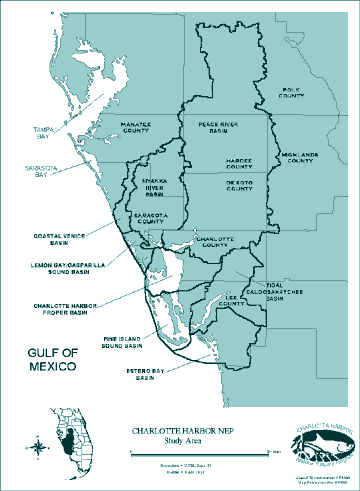 Charlotte Harbor and its major tributaries are located in Floridaís
southern central interior and southwestern coast. The Charlotte Harbor watershed
is one of the largest watershed systems on the southwest Florida coast, covering
more than 4,400 square miles, incorporating three major river basins within
southwest Florida. The Peace and Myakka Rivers flow directly into Charlotte
Harbor, while the Caloosahatchee River connects to Charlotte Harbor through Pine
Island Sound and Matlacha Pass. In addition to these major rivers, the watershed
includes the Winter Haven Chain of Lakes, Coastal Venice, Lemon Bay, and Estero
Bay. Charlotte Harbor is the nationís 18th largest estuarine system and is an
important part of the Gulf of Mexico watershed.
Charlotte Harbor and its major tributaries are located in Floridaís
southern central interior and southwestern coast. The Charlotte Harbor watershed
is one of the largest watershed systems on the southwest Florida coast, covering
more than 4,400 square miles, incorporating three major river basins within
southwest Florida. The Peace and Myakka Rivers flow directly into Charlotte
Harbor, while the Caloosahatchee River connects to Charlotte Harbor through Pine
Island Sound and Matlacha Pass. In addition to these major rivers, the watershed
includes the Winter Haven Chain of Lakes, Coastal Venice, Lemon Bay, and Estero
Bay. Charlotte Harbor is the nationís 18th largest estuarine system and is an
important part of the Gulf of Mexico watershed.
There are 23 local governments in the Charlotte Harbor watershed, including Lakeland, Venice, Fort Myers, and Arcadia. The area is divided into a number of districts and jurisdictions, creating significant political challenges in terms of managing the watershed as an entire system. Upland areas in the watershed are dominated by agricultural activities and phosphate mining, while the coastal areas are more urbanized and undergoing rapid population growth. Maintaining water quality, wildlife habitat, and water supplies are concerns throughout the region as human populations grow and land use intensifies. Resolving these issues requires cooperative management in the private sector and across all levels of government.
The Problem
The rate of development in Charlotte County has been increasing since the 1940s. This early development led to large areas of wetlands being dredged and filled for residences. More than 200 miles of navigable canals are now part of the residential landscape of the metropolitan area along Charlotte Harbor where the Peace River enters into the harbor.
Charlotte Harbor has important recreational and commercial fisheries, including important species such as the tarpon (Megalops atlanticus), snook (Centroponus undecimalis), and spotted sea trout (Cynoscion nebulosus). Estuarine species are threatened by loss of vital habitats such as seagrass beds and fishing pressures. Fisheries habitats can be damaged by boats, dredging, nutrient overloading, and conversion of wetlands to upland area. The importance of fish populations to the Charlotte Harbor system has resulted in efforts to enhance fish habitat, control damage to seagrass beds, improve water quality and implement significant restrictions on fishing methods.
Introduction to Charlotte Harbor
Charlotte Harbor is located in sub-tropical climate and its watershed contains large tracts of undeveloped areas which provide habitat for a wide array of rare plants and animals. General characteristics of Charlotte Harbor and its watershed include:
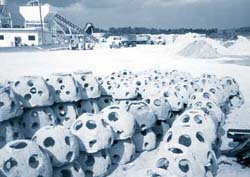 The Charlotte Harbor National Estuary Program, Florida Department of
Environmental Protection, Reef Ball Foundation, Inc., and the Charlotte Harbor
Reefs Association formed a partnership to improve existing water quality and
creating new juvenile fishery habitats in these residential canals, as well as
under piers around the mouth of the Peace River and in the main body of
Charlotte Harbor. The partnership chose to construct and deploy five hundred
Reef Balls in specified areas. Reef Balls are made of concrete, placed on the
seafloor bottom, and provide a habitat for juvenile fish. Forty volunteers from
the Charlotte Harbor Reefs Association worked full time for nearly four months
to construct the concrete modules, using molds donated by the Reef Ball
Foundation, Inc. Three types of sites were chosen for fish habitat improvement
through the introduction of Reef Balls, including existing artificial reefs,
under private docks, and under public piers.
The Charlotte Harbor National Estuary Program, Florida Department of
Environmental Protection, Reef Ball Foundation, Inc., and the Charlotte Harbor
Reefs Association formed a partnership to improve existing water quality and
creating new juvenile fishery habitats in these residential canals, as well as
under piers around the mouth of the Peace River and in the main body of
Charlotte Harbor. The partnership chose to construct and deploy five hundred
Reef Balls in specified areas. Reef Balls are made of concrete, placed on the
seafloor bottom, and provide a habitat for juvenile fish. Forty volunteers from
the Charlotte Harbor Reefs Association worked full time for nearly four months
to construct the concrete modules, using molds donated by the Reef Ball
Foundation, Inc. Three types of sites were chosen for fish habitat improvement
through the introduction of Reef Balls, including existing artificial reefs,
under private docks, and under public piers.
The primary objective of the project was to provide more habitat for fisheries and to improve fishery production in Charlotte Harbor. In addition to fish habitat enhancement, the Reef Balls encourage the colonization of oysters and other marine organisms, which filter the water and provide a forage base for certain species of fish.
The Charlotte Harbor project areas were chosen for fish habitat enhancement for the specific purpose of providing fishermen a fishing destination. Much of the damage to natural spawning grounds in the Harbor occurs when fishermen traverse seagrass beds looking for fish. Seagrass beds provide important habitat for fish by providing shelter and food, and are particularly important for nursery habitat. Providing fishermen a specific fishing destination will help to divert fishermen away from shallow waters and seagrass beds to an easily accessible location in deep water.
The placement of Reef Balls under the piers at the mouth of the Peace River in the upper portion of Charlotte Harbor and adjacent to downtown Punta Gorda, was done to create high quality habitat and attract fish to these sites. The three piers chosen for the project extend into the river from two parks along the water and are heavily used by the public for nature watching and fishing. Fishermen and nature lovers alike will be able to enjoy the large populations of fish from these easily accessible piers.
Project Implementation
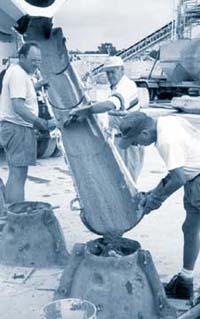 The project was initiated by a group of conservation-minded fishermen
who formed the Charlotte Harbor Reefs Association, Inc., a non-profit
corporation. Driven by the desire to increase the number of fish in Charlotte
Harbor, the group gathered information on how to best accomplish this goal and
improve the aquatic resources of Charlotte Harbor. During the planning phase it
was determined that concrete Reef Balls were the most environmentally compatible
and appropriate type of fishery habitat for the project. With the support of
many fishermen, as well as a number of public and private organizations, the
Association set up a plan of action that included the construction and
deployment of 500 Reef Balls in three distinctly different environments within
Charlotte Harbor.
The project was initiated by a group of conservation-minded fishermen
who formed the Charlotte Harbor Reefs Association, Inc., a non-profit
corporation. Driven by the desire to increase the number of fish in Charlotte
Harbor, the group gathered information on how to best accomplish this goal and
improve the aquatic resources of Charlotte Harbor. During the planning phase it
was determined that concrete Reef Balls were the most environmentally compatible
and appropriate type of fishery habitat for the project. With the support of
many fishermen, as well as a number of public and private organizations, the
Association set up a plan of action that included the construction and
deployment of 500 Reef Balls in three distinctly different environments within
Charlotte Harbor.
The Charlotte Harbor Reefs Association sought and obtained funding from a variety of sources, including the Charlotte Harbor National Estuary Program and Florida Department of Environmental Protection. In-kind support services were provide by Reef Balls Foundation, Inc., who donated the molds and assisted in placing the Reef Balls on site, and the Florida Sea Grant Extension office provided technical assistance.
The process for obtaining the necessary permits began in July of 1997. Placing Reef Balls under private docks in dredged canals within the Punta Gorda Isles residential area was a first of its kind project. Obtaining permits for this phase required considerable time and effort. It is expected that the great success of the project will encourage state agencies to allow this kind of project to be conducted in other areas of Florida.
Fisheries habitat enhancement in the east central part of Charlotte Harbor involved renourishing an already established artificial reef. Once permits and additional funding were obtained for this project, 210 reef balls were added in two phases to a marginally productive reef created 10 years earlier using construction rubble. The site, located in a more offshore environment than the other locations chosen for enhancement, is a mile in length and 150 feet wide, with water depths ranging from 13 to 16 feet.
The final project involved providing fishery habitat under public piers where it would be accessible to everyone. Three existing park areas on the Peace River were selected, and the Reef Balls were recently deployed.
Success of the Project
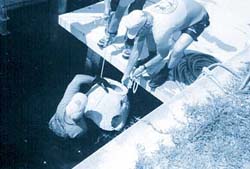
Although the Reef Balls have only recently been deployed, ongoing monitoring has provided some initial observations:
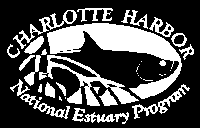 Jerry Jensen, President
Jerry Jensen, President
Charlotte Harbor Reefs Association
33
Tropicana Drive
Punta Gorda, FL 33950
Phone: (941) 637-0005
For further information on the Reef Ball Foundation, visit the website at http://www.reefball.org/ ![]()
| EPA HOMEPAGE | WATER HOME | HOTLINES | SEARCH | COMMENTS Environmental Protection Agency's Office of Wetlands, Oceans, & Watersheds |